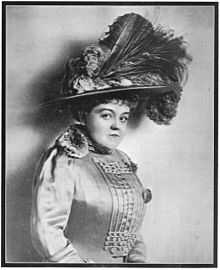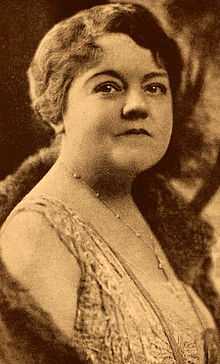Marie Cahill
| Mary "Marie" Cahill | |
|---|---|
 | |
| Born |
Mary Cahill December, 1866 Brooklyn, New York |
| Died |
August 23, 1933 (Aged 66) New York City, New York |
| Occupation | Actress/Vocalist |
| Years active | 1888-1933 |
| Spouse(s) | Daniel V. Arthur |

Marie Cahill (December, 1866[1] – August 23, 1933) was a Broadway stage actress and vocalist. Her parents were Irish immigrants Richard and Mary (née Groegen) Cahill.[2] She had an older brother named Richard.[3] Both her father and brother ran a brush making business.
Marie began her career in the late 1880s first in her native Brooklyn and then on Broadway. In 1902 in the show Sally In Our Alley she introduced the song Under The Bamboo Tree which became her signature song and one of the most famous songs from the turn of the century. Also in 1902 in the musical The Wild Rose she premiered another hit song Nancy Brown. In 1903 the popularity of the Nancy Brown song was expanded into its own musical for Cahill, and became her favorite role. She had a plump and jolly demeanor and in addition to being a singer she presented herself as a conversationalist in a style that at best anticipates the later Gracie Allen. Daniel Blum in Great Stars of the American Theatre c. 1952 relates that Cahill was a very proper woman who didn't tolerate naughty behavior or salaciousness. However in contrast she could don a pair of tights in a musical and exude sex appeal. In appearance she resembled rival Della Fox.[4]
Movies and other media
Cahill recorded her voice and routines at several gramophone recording sessions in the years 1917 to 1924 all in the acoustical recording method. She also had recorded her signature song Under The Bamboo Tree in 1902.[5] In 1915 Cahill appeared in her first silent film, Judy Forgot, based on her musical comedy of the same name performed on Broadway in the 1911 season.[6] In 1917 she appeared in three more silent films, Gladys' Day Dreams, When Betty Bets and Patsy's Partner before giving up on the medium.
Several of her voice recordings (monologues), made between 1916 and 1924, are on file at the Library of Congress' National Jukebox. They include "Washing baby" (1921), "The symphony concert" (1923) and "At the theatre" (1924). "At the theatre" takes the form of a telephone conversation with an unheard party in which Cahill, as "Mrs. Pinthrop," describes goings-on—including the appearance of Marie Cahill ("Irish, I guess... well, maybe she is Jewish") -- at the Palace Theatre.
Personal life
Cahill married Daniel V. Arthur on June 18, 1903 a union that lasted until she died on August 23, 1933. Daniel Arthur survived his wife by six years,[7] dying on December 6, 1939.[8]
References
- ↑ 1870, 1880 and 1900 Federal Census. The previous Wiki reference to a 1952 source showing February 7, 1870, is in conflict with the information gathered from those three census records in addition to other sources. The age of Mary Cahill in 1880 was 13 and in 1900 the census clearly showed December, 1866.
- ↑ Notable American women, 1607-1950: a biographical dictionary, Vol.2 by Edward James & Janet Wilson James
- ↑ The previous Wiki reference to a 1950 profile listed a Daniel as her brother, but the 1870, 1880 and 1900 Federal Census all show Richard, who was two years older. He is also mentioned in newspaper references from 1903 when Marie was married.
- ↑ Marie Cahill - North American Theatre Online
- ↑ Vitaphone Varieties=Enigmarelle & Co. a page on historic Vitaphone recordings 2008
- ↑ Internet Broadway Database: Marie Cahill(Judy Forgot)
- ↑ Who Was Who in the Theatre 1912-1976 John Parker material compiled by Gale Research c.1976
- ↑ Yonkers Herald Stateman, December 7, 1939
External links
- Marie Cahill at IBDb.com
- Marie Cahill at IMDb.com
- Marie Cahill portrait gallery New York Public Library, Billy Rose collection
- Marie Cahill portraits University of Louisville Macauley Theatre Collection photo 1., photo2.
- Selection of Marie's recordings at InternetArchive.org
- Several of Marie's monologues at the Library of Congress National Jukebox
- Marie Cahill; PeriodPaper.com circa 1910
- complete Marie discography; Victor Records
- findagrave.com
|